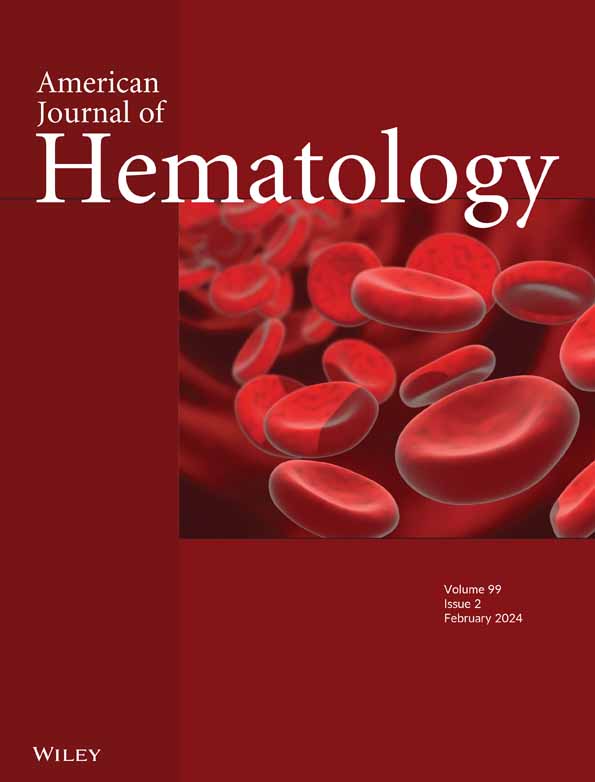异基因干细胞移植最佳CPX-351治疗时间和时机的真实世界研究。
IF 9.9
1区 医学
Q1 HEMATOLOGY
引用次数: 0
摘要
在注册临床试验301 (NCT01696084)中,CPX-351在继发性AML (s-AML)中的疗效优于常规的3 + 7。然而,治疗的最佳持续时间、同种异体干细胞移植的最佳时机以及CPX-351在特定s-AML亚群中的活性尚不清楚。为了评估这些方面,我们回顾性分析了513例接受CPX-351治疗的s-AML患者(中位年龄65.6岁,19-79岁)。诱导后的完全缓解率(CR)为297/513(58%),第2周期后增加到340/513(66%)。在340例有应答的患者中,分别有118例(34.7%)、137例(40.3%)和85例(25%)未接受CPX-351巩固治疗。总体而言,513例患者中有230例(48.8%)接受了同种异体造血干细胞移植。中位随访时间为23.66个月,中位总生存期(OS)为16.23个月。NPM1突变或ELN 2017有利风险患者(p < 0.05)的总生存期明显延长(p < 0.05)。在一项具有里程碑意义的分析中,接受同种异体移植与更长的生存期相关(接受或未接受同种异体移植的患者未达到中位生存期vs. 16.3个月,p < 0.05)。完成所有允许的CPX-351周期仅对不进行移植的患者有益(p < 0.05),而在移植患者中,额外的CPX-351周期并没有改善结果。我们的分析表明,NPM1突变的s-AML患者和属于ELN 2017有利风险类别的患者也受益于CPX-351。在符合条件的患者中,一旦达到CR,应立即进行同种异体造血干细胞移植,而未接受移植的患者则受益于完整的CPX-351计划。本文章由计算机程序翻译,如有差异,请以英文原文为准。
Real World Study on the Best CPX-351 Treatment Duration and Timing for Allogeneic Stem Cell Transplantation.
In the registration clinical trial 301 (NCT01696084), CPX-351 has shown to be superior to conventional 3 + 7 in secondary AML (s-AML). However, the optimal duration of treatment, the best timing for allogeneic stem cell transplantation (allo-HSCT), and the activity of CPX-351 in specific s-AML subgroups are unclear. To evaluate these aspects, a total of 513 s-AML patients (median age 65.6 years, 19-79) treated with CPX-351 were retrospectively analyzed. Complete remission (CR) rate after induction was 297/513 (58%), increasing to 340/513 (66%) after cycle 2. Among the 340 responding patients, 118 (34.7%), 137 (40.3%), and 85 (25%) received none, one, or two consolidation cycles of CPX-351, respectively. Overall, 230/513 patients (48.8%) received allo-HSCT. Median follow up was 23.66 months and median overall survival (OS) was 16.23 months. Patients with mutated NPM1 or with ELN 2017 favorable risk (p < 0.05) had a significantly longer OS (p < 0.05). In a landmark analysis, receiving allo-HSCT was associated with a longer survival (Median OS not reached vs. 16.3 months for patients receiving or not receiving allo-HSCT, p < 0.05). Completion of all allowed CPX-351 cycles was beneficial only in patients not proceeding to transplant (p < 0.05), whereas in transplanted patients additional CPX-351 cycles did not improve outcome. Our analysis suggests that also s-AML patients with NPM1 mutations and those belonging to the ELN 2017 favorable risk category benefit from CPX-351. In eligible patients, allo-HSCT should be performed as soon as a CR is achieved, whereas patients not undergoing transplant benefit from a complete CPX-351 schedule.
求助全文
通过发布文献求助,成功后即可免费获取论文全文。
去求助
来源期刊
CiteScore
15.70
自引率
3.90%
发文量
363
审稿时长
3-6 weeks
期刊介绍:
The American Journal of Hematology offers extensive coverage of experimental and clinical aspects of blood diseases in humans and animal models. The journal publishes original contributions in both non-malignant and malignant hematological diseases, encompassing clinical and basic studies in areas such as hemostasis, thrombosis, immunology, blood banking, and stem cell biology. Clinical translational reports highlighting innovative therapeutic approaches for the diagnosis and treatment of hematological diseases are actively encouraged.The American Journal of Hematology features regular original laboratory and clinical research articles, brief research reports, critical reviews, images in hematology, as well as letters and correspondence.

 求助内容:
求助内容: 应助结果提醒方式:
应助结果提醒方式:


